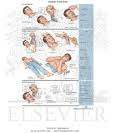
GCS (Glasgow Coma Scale) is a scale used to assess the level of awareness of patients by assessing patient response to stimuli provided. Stimulus given many things by observing the reaction consists of three eye-opening reaction (Eye (E)), verbal response (V), speech and motor movement.
Eye (eye-opening response):
This eye-opening response is an initial response when we meet with clients. There was the expected response in patients with reflex eye-opening is how the client. Is he going to spontaneously open the eye without having to be called names, being touched or given a pinch. For the value of this response we value (4) or spontaneous response. If the eyes are open, with sound stimuli, as we call the client's name, then we love the response to E values (3). If the client can open the eyes when we gave pain stimuli, (eg by pressing a fingernail), then the value of E clients (2). When no response at all, then we give the value of E (1), no response.
Verbal (verbal response)
After we analyze the eye-opening reflex, then the next assessment is how we assess the client's verbal response. When the client can know where he is, who he is, kjalimat well spoken, good orientation, we value the verbal response from the numbers (5). If the client confused, talk to screw up (frequently asked repeatedly) disorientation place and time, then the value we give a verbal response score (4). For the value (3) we give when the client does not speak clearly (but words are still clear, but not in one sentence) and expresses only short words like "gosh ... the father ...". If the client more groan or make a sound without meaning, so we value client verbal response (2). When still no response, then we give the client a verbal value.
Motor (motor response)
This motor response please be with the assessment of muscle strength yes. This check back again I remind you is only used to determine the level of awareness of the client with the client to monitor motor response. When the client was ordered to do what we want, like asking her to raise their hands, or when we arrived and then we give our hands to shake hands dengnnya. We can see the client's response is there or not to do it (shake hands with us). If there is, or follow the instructions we give, so we value client's motor response (6).
We can provide a stimulus such as pain stimuli. When the client is able to localize the pain with how to keep stimulus pain stimulus when given, then we give the value (5). If the client's avoidance of interesting given extremity or body away from the stimulus when the stimulus was given pain stimulus) we can give the value of M (4).
For the provision of value M (3), we can see it when clients away / pulling away from the extremity or body when given excitatory stimulus pain with the flexi abnormal response (one or both arms rigid position on the chest and leg extensions when given a painful stimulus). while to give the value of M (2) didapakan client response in the form of abnormal extension (one or both extension arms at your sides, with the fingers into a fist & foot extension when given painful stimuli). When the client there is no response, then we value M (1).
GCS Assessment
- The assessment of consciousness based on GCS expressed in symbols E ... M ... V ...
- Furthermore, the values summed. GCS is the highest value is 15 which is the third lowest E4M6V5 and is E1M1V1.
- Assessing the status of client awareness
GCS: 14-15 = CKR (mild head injury)
GCS: 9-13 = CKS (moderate head injury)
GCS: 3-8 = CKB (severe head injury)
<3 = coma





Tidak ada komentar:
Posting Komentar